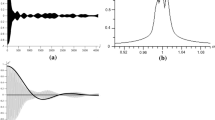Abstract
The susceptibility of a modified version of the one-dimensional kinetic Ising model is obtained and compared with the susceptibility of the Glauber version of this model. Spin-flip rates in the new model are picked so no spin-flip rate vanishes as the temperature vanishes. Despite the more rapid spin flips, the new model exhibits an infinitely slow approach to equilibrium in the low-temperature limit which is similar to the slowing down exhibited in the Glauber model. The new model also exhibits two different decay rates toward equilibrium, which are called the transient and slow decay rates. The Glauber model is characterized by only a single decay rate toward equilibrium.
Similar content being viewed by others
References
R. J. Glauber,J. Math. Phys. 4:294 (1963).
R. Kikuchi,Ann. Phys. (N.Y.) 10:127 (1960),11:306 (1960); Ya. Yu. Gotlib,Sov. Phys.-Solid State 3:1577 (1962).
K. Kawasaki, inPhase Transitions and Critical Phenomena, Vol. 2, C. Domb and M. S. Green, eds. (Academic Press, New York, 1972).
K. Binder, inPhase Transitions and Critical Phenomena, Vol. 5b, C. Domb and M. S. Green, eds. (Academic Press, New York, 1972).
K. Kawasaki,Phys. Rev. 145:224 (1966);148:375 (1966);150:285 (1966).
H. Yahata and M. Suzuki,J. Phys. Soc. Japan 27:1421 (1969).
H. Yahata,J. Phys. Soc. Japan 30:657 (1971).
A. Baumgartner and K. Binder,J. Stat. Phys. 18:423 (1978).
H. J. Hilhorst,Physica A79:171 (1975).
E. Stoll, K. Binder, and T. Schneider,Phys. Rev. B 8:3266 (1973).
M. Suzuki,Int.J. Magn. 1:123 (1971).
Z. Racz and M. F. Collins,Phys. Rev. B 13:3074 (1976).
N. J. White,J. Phys. C 9:L187 (1976).
Z. C. Sepes and Z. Racz,J. Phys. A 11:575 (1978).
M. Suzuki and R. Kubo,J. Phys. Soc. Japan 24:51 (1968).
W. Kinzel,Z. Phys. B 29:361 (1978).
Y. Achiam,J. Phys. A 11:975 (1978).
L. P. Kadanoff and J. Swift,Phys. Rev. 165:310 (1968).
R. Kubo,J. Phys. Soc. Japan 12:570 (1957).
B. I. Halperin,Phys. Rev. B 8:4437 (1973).
P. C. Hohenberg and B. I. Halperin,Rev. Mod. Phys. 49:435 (1977).
Author information
Authors and Affiliations
Additional information
Work supported in part by National Science Foundation grant DMR 78-03408.
Rights and permissions
About this article
Cite this article
Kimball, J.C. The kinetic Ising model: Exact susceptibilities of two simple examples. J Stat Phys 21, 289–300 (1979). https://doi.org/10.1007/BF01011471
Received:
Revised:
Issue Date:
DOI: https://doi.org/10.1007/BF01011471




